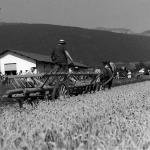|
Lumière Dialux |
Manufactured or assembled in France from (Circa) 1935 to (After) 1935.
Index of rarity in France: Infrequent (among non-specialized garage sales)
Inventory number: 13876
See the complete technical specifications
Chronology of cameras Lumiere
The Dialux cameras are luxurious folding cameras that were featured in Lumière's catalogs from 1931 to 1936. In the first year, the model was only available in the 6.5 x 11 format, as Lumière still offered the Nada in 6 x 9. The Dialux in 6 x 9 cm format was introduced in 1932, and both formats coexisted until the end of production. These cameras were automatic, meaning that when opened, the folding bed unfolded completely, and the lens had to be in position without further intervention. The scissor mechanisms underwent some modifications. In 1931, they had the same shape as those of the Nada. From 1932 onwards, their shape changed and remained the same until the end of production. Some models had a folding bed release lever on the bed itself.
The cameras were manufactured with an aluminum body and a reinforced metal folding bed. The covering was made of morocco leather, initially in some cases with fancy leather, imitation reptile patterns. In 1933, a version with lacquered side panels was offered alongside the fully covered variant. There were two viewfinders, except on some examples with lacquered side panels, which had only the frame viewfinder. The frame viewfinder momentarily changed its position in 1932 to be centered relative to the lens axis. The strut stand could be ornate, featuring a design that incorporated the logo. This shape was present on the early variations.
The shutter was relatively simple, with speeds up to 1/100. At the beginning, it was sometimes referred to as a "Vario," but Lumière, claiming French manufacture, often remained discreet about its branding. A self-timer feature appeared in 1934.
The bellows were made of leather.
Two lenses were offered throughout the model's production. These were the Nacor f/6.3 and the Spector f/4.5. Starting in 1931, some catalogs featured other French lenses: Lumière Nacor 6.3, Boyer Topaz 6.3, Roussel Trylor 6.3, or Berthiot 6.3, as well as Lumière Spector 4.5, Boyer Topaz 4.5, Roussel Trylor 4.5, or Berthiot 4.5. It's challenging to determine how long these lenses were offered, as their absence from catalogs could be due to distributor preferences not to clutter with numerous variants.
Cet exemplaire de Dialux comporte, derrière la béquille, le numéro de série C2106. D'après les « Chiffres Clés » de P.H. Pont (ISBN 2-912848-14-8) la lettre C du début du numéro correspond à l'année 1933. Si les joues laquées sont en accord avec la date donnée par la béquille puisqu'elles apparaissent avec le nouveau modèle luxe de 1933, plusieurs autres éléments sont en contradiction.
Pour l’avancement du film, cet exemplaire est équipé d’un gros bouton moleté, qui d'après McKeown n'apparaît qu'à partir de 1935, en remplacement d'une clé.
L'obturateur avec son gros voyant rouge du retardateur n’apparaît qu’en 1934 chez Tiranty.
Le bouton commandant le verrou de l'abattant disparaît après 1935.
Si les catalogues sont une aide précieuse, ils laissent parfois subsister des incertitudes. La gravure ne montre qu'un côté de l'appareil, alors que le côté masqué peut être déterminant pour une identification précise. Le millésime des catalogues est également source de confusion. Tous les distributeurs ne les éditaient pas au même moment de l'année. Dans certains cas, le délai entre la préparation de leur mise en page et leur diffusion était assez long pour être à cheval sur deux années. Certains éditeurs ne s'encombraient pas d'exactitude et continuaient à utiliser la même gravure pour un modèle ayant subi des modifications importantes.
Donc pour cet exemplaire, il a été impossible de trouver une illustration correspondant exactement, et nous avons retenu 1935 comme année probable de commercialisation.
L’objectif Spector f/4,5 de cet exemplaire était déjà proposé sur les anciens Dialux, mais il coûtait bien plus cher que le plus modeste Nacor ouvrant à 6,3 : respectivement 350 contre 275 francs.

Interesting links or bibliography :
Add a link or element of bibliography, a picture taken with this camera, a picture of box or an ads about this camera
Your photos taken with the same camera:
Cameras from Ebay France (Lumière) (Uploaded each 3 hours)







